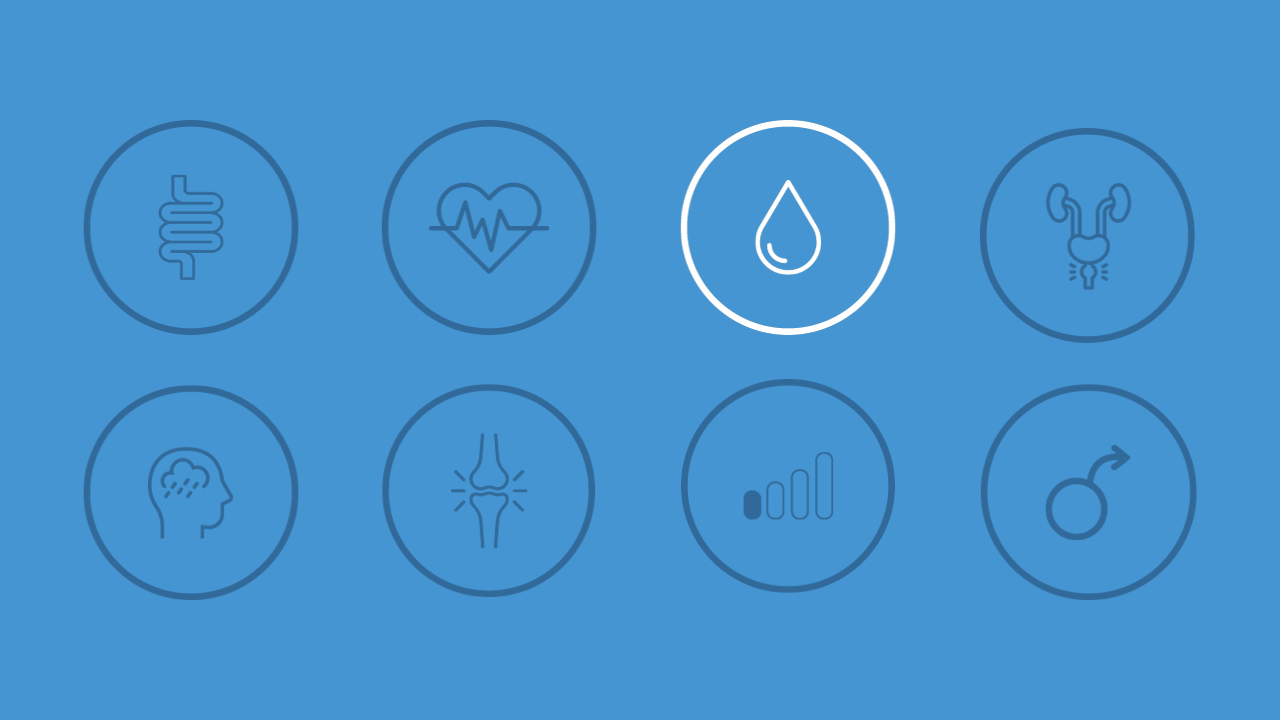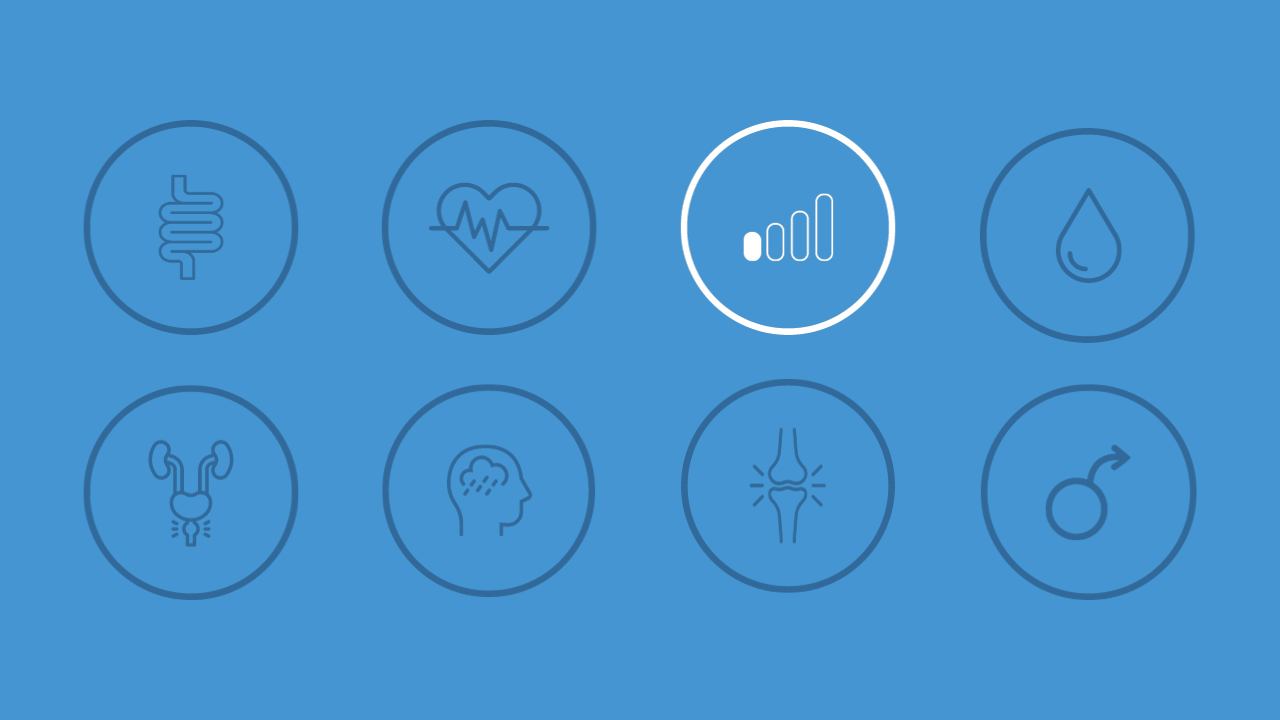Osteoporosis
Your questions answered on osteoporosis in men. Including information about signs and how to help prevent it through simple lifestyle choices.
Medically reviewed by:

MB, BCh, FRCPC
At least one in five men will break a bone from osteoporosis
What is osteoporosis ?
Osteoporosis is a bone disease that leads to weak bones, and an increased risk of fractures.
Our bone cells are constantly being renewed by new bone cells, which keeps our bones strong. This cycle naturally declines as we age. In osteoporosis, bones deteriorate faster than normal. When left untreated, bones can become so weak a simple act such as reaching, bending over, or sneezing can cause a fracture.
It is more common in men over age 65 but can affect all ages. Osteoporosis can occur over a number of years without warning signs, which is why screening is recommended at age 65 or earlier.
Signs & Symptoms
The first warning sign of osteoporosis is often a bone fracture. Other signs include losing height and stooping posture with lower back pain.
Typical fractures happen in the hip, spine, wrist or shoulder. Fractures are not only painful but can take weeks to months to heal, sometimes requiring surgery or ongoing physical therapy.
Common fractures from osteoporosis include:
- Fragility fractures: a fracture that occurs spontaneously from a simple activity like reaching, twisting or coughing. Or from a minor injury like a fall from standing height.
- Height loss and spine fracture: A decrease in height by 2cm from maximum height could indicate a spine fracture. These are usually painless but will show up on an x-ray.
Risk Factors
There is no single cause of osteoporosis. A number of risk factors exist that can increase the chances of developing it, however many people only have a few of them.
Common risk factors:
- Age (over 65+ in men)
- Low calcium or vitamin D intake
- Family history of a hip fracture
- Lack of physical activity
- High alcohol consumption (3+ drinks per day)
- Smoking
- Low body weight or major weight loss
- Long-term use of certain medications
- Certain medical conditions associated with bone loss (i.e., diabetes, rheumatoid arthritis, celiac disease, gastric bypass surgery, and others)
Are You At Risk?
Learn your risk level for the most common men’s health conditions in 10 minutes with a free, confidential, and personalized report.
Screening
Men are less likely to be assessed for osteoporosis or to receive treatment after they break a bone
Osteoporosis Canada
Osteoporosis is a silent disease, meaning it can develop for years without symptoms. A one-time bone mineral density test (a safe, painless scan) is recommended for men between 65 – 70. If you have increased risk factors such as a family history or high alcohol intake, a scan may be considered as early as age 50.
If you are taking high-risk medications or have a condition associated with bone loss, consult your healthcare practitioner for the appropriate screening age and frequency.
Download the Men’s Health Checklist for a full list of what tests you need, and when to screen for common men’s health conditions.
Diagnosis
Osteoporosis is diagnosed by a healthcare practitioner using the results of the bone mineral density test (DEXA scan), combined with health history and clinical risk factors. A fracture risk assessment will identify your risk as low, moderate or high over the next 10 years.
Prevention
Get Active
Regular physical activity helps slow the rate of bone loss, prevent falls and protect the spine. On a weekly basis, aim for 150 mins of heart-pumping activity and 2 strength training sessions using weights, bands or your own body weight.
Eat Healthier
Getting enough calcium, vitamin D and protein from a combination of your diet and or supplements is necessary to provide the building blocks for your bones.
Calcium-rich food examples include dairy products, fortified milk alternatives, and salmon. You can support your vitamin D intake through some foods like egg yolks and saltwater fish. Up your protein intake by incorporating plant-based sources like beans, nuts and seeds.
Quit Smoking
Long-term smoking is associated with an increased risk of osteoporosis. Quitting smoking will help reduce your risk of many serious health conditions.
Drink Less
Consuming three or more alcoholic drinks per day is associated with an increased risk of osteoporosis. Lowering your alcohol intake has many additional health benefits beyond bone health.
Get Easy Tips To Reduce Your Risk
Treatment
Treatment is focused on helping prevent bones from weakening further and reducing the risk of falls and fractures.
It’s important to first identify and manage any medications or coexisting conditions that can contribute to osteoporosis.
Your healthcare practitioner may prescribe drug therapy depending on your risks and treatment needs. This can include drugs that slow down bone loss and/or build up bone density.
Drug therapy may be paired with a regular strength training routine and getting the required amount of calcium and vitamin D through diet and/or supplements.
Frequently Asked Questions
A Guy’s Guide to Eating Healthy
Make healthy eating easier with simple dietitian tips, food facts and recipes made for men.

proudly sponsored by:

Medically reviewed by:

Dr. Larry Dian, MB, BCh, FRCPC
Dr. Dian is a practicing Geriatrician at Vancouver General Hospital and a Clinical Professor with the University of British Columbia.
More about Dr. Larry Dian



